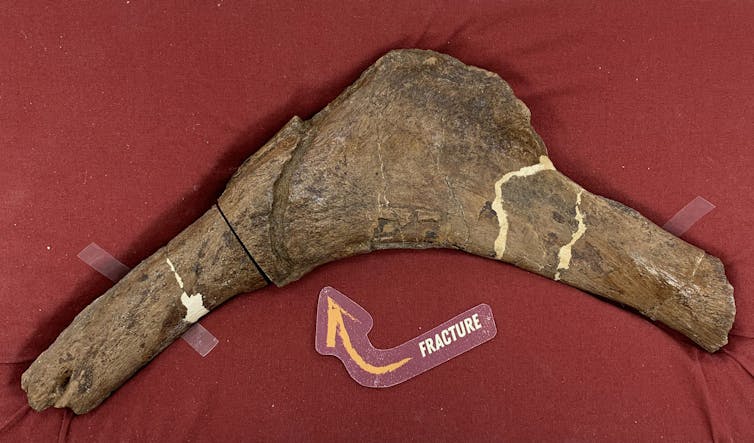Source: The Conversation – Canada – By Afsoon Soudi, Assistant Professor, RTA school of Media, Toronto Metropolitan University

Many writers, actors and other creatives are currently experiencing a small wave of panic about artificial intelligence (AI) taking over their jobs.
Generative AI (GenAI) is making machine learning and creative work more accessible to everyone. But for industry professionals, the rise of generative AI can signal the destruction of creative jobs.
Yet, according to a recent report by the World Economic Forum, AI will create more jobs in the next five years than it will displace.
We are four scholars in different creative industries hoping to explore educational approaches to AI. We want to help prepare the next generation to innovate within human-AI collaborative frameworks. To do this, we have begun to confer with other creative professionals through an online survey.
What if AI can actually support human creativity and productivity? Can we use these technologies to our advantage? What we can expect for the future?
We believe creative professionals can harness new technologies while still upholding their foundational creative and ethical principles.
How AI is being used in creative sectors
AI is becoming deeply embedded within the operational workflows of creative industries, from a nascent concept to an integrated reality.
Media and creative workers have gone on strike to protest the use of AI, sparking important conversations. For example, Screenwriters in Hollywood and the Writers’ Union of Canada have raised concerns and helped shape new policies around AI and creative work.
Within media production, large language models (LLMs) can facilitate the rapid prototyping of narrative concepts, scripts and audiovisual materials, while automated editing platforms and AI-driven visual effects create massive efficiency gains in post-production. This technological integration allows creators to shift their focus from laborious manual tasks to higher-level creative refinement.
In graphic communication and packaging, AI and machine learning are acknowledged drivers of change. AI can enhance processes from ideation to production logistics like sorting and personalized web-to-print platforms. In the realm of Digital Asset Management, AI is instrumental in improving asset discoverability and utility through automated metadata tagging and sophisticated image recognition.
Journalism is also undergoing a significant transformation. AI has been used for a while now to analyze large datasets for investigative reporting, but LLMs now routinely streamline article summarization. More advanced applications are emerging: AI systems are designed to identify news values and auto-generate articles from live events. Major news organizations like the Financial Times and The New York Times are already deploying AI tools in their newsrooms.
Ethical challenges
The integration of AI is not without considerable challenges.
The generation of fabricated information and non-existent sources are documented failures. These examples highlight critical issues with accuracy and reliability.
Many people have said they do not fully understand the extent to which AI is incorporated into their standard software. This disparity between deployment and user consciousness underscores the subtle yet pervasive nature of AI’s integration. This points to an urgent need for greater transparency and digital literacy.
Bias and intellectual property
Models trained on vast, uncurated internet data often replicate and amplify existing societal biases. For example, studies demonstrate persistent issues such as anti-Muslim bias in LLMs.
Read more:
Artificial intelligence can discriminate on the basis of race and gender, and also age
At the same time, urgent ethical and legal questions regarding intellectual property have emerged. The training of LLMs on copyrighted content without compensation has created significant friction. For example, the pending New York Times litigation against OpenAI highlights unresolved issues of fair use and remuneration for creative work.
Conversely, GenAI demonstrates considerable potential to democratize creative production. These tools, by lowering technical barriers and automating complex processes, can provide access to individuals and groups historically excluded from creative fields due to resource or educational constraints.
Specific applications are already enhancing media accessibility, such as AI-powered tools that automatically generate alt text for images and subtitles for video content.
Navigating this dual-use landscape necessitates the adoption of robust governance frameworks. Fostering industry-wide equity, diversity and innovation education is essential to mitigate risks while harnessing GenAI’s potential for an inclusive creative ecosystem.
Labour and skill evolution
Technological revolutions have historically catalyzed significant transformations in creative labour markets and GenAI represents the latest disruptive force.
The proliferation of GenAI has once again reshaped the creative industries, demanding new professional competencies.
Human creativity and intervention are indispensable, providing cultural and contextual accuracy. Humans must also review AI-generated content for quality and inclusivity.
In response to this shift, higher education institutions need to recalibrate curricula from tool-specific training towards fostering curiosity, ethical reasoning and AI literacy.
![]()
The authors do not work for, consult, own shares in or receive funding from any company or organisation that would benefit from this article, and have disclosed no relevant affiliations beyond their academic appointment.
– ref. Is AI coming for your creative job? Maybe not – with some human intervention – https://theconversation.com/is-ai-coming-for-your-creative-job-maybe-not-with-some-human-intervention-252796












